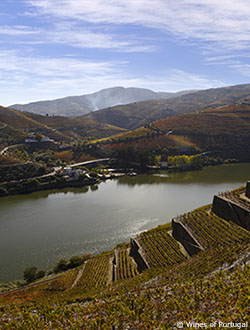Douro Wines
One of the most majestic wine regions in the world, and home to one of the most famous and world class fortified wines, Port. It’s a wild, rugged land, still relatively remote, despite improved road connections and hotels over recent years, and a place of simply staggering beauty. The steep, terraced vineyards, clinging to the sheer, schist and slate soils, rise imperiously above the river Douro, which begins its journey as the Spanish river Duero.

Traditionally, and still, the home of Port, it is only in relatively recent years, that the Douro region has come to prominence for the production of some very serious, top notch table wines. The reds are largely based on the same grape varieties used in Port production, Touriga Nacional, Touriga Franca, Tinta Roriz (Tempranillo), Tinta Barroca and Tinta Cao, as well as some influence from Cabernet Sauvignon and other international grape varieties. One recently rising Portuguese star in the region is Sousao which creates fresh red wines even in the hottest years. The whites are made from traditional native Douro grapes, including Viosinho, full-bodied with floral and stone fruit flavours, Rabigato, high acidity, citrus and floral notes, Gouveio, known as Godello in Spain, and some Moscatel Galego Branco, Muscat Blanc à Petits Grains in France.
The Douro region is naturally split into 3 areas, the upper, the middle and the lower Douro. The middle Douro (Cima Corgo) based around the town of Pinhao, is where the majority of the Port production is based, with this part of the Douro producing over half the total wine production. This is where the iconic Port estates, or quintas, are housed, nestled in the splendid isolation and peace of the vineyards. The lower Douro (Baixa Corgo) has traditionally produced most of the table wine, on the lower, easier to reach slopes. However, more wine is now being produced on the steep slopes of the middle Douro and also the upper Douro (Douro Superior), wines that are more premium partly because of the difficult nature of growing and harvesting the grapes. The low yields, intense sunlight and the stressed vines, make for some superb, intense, complex reds.